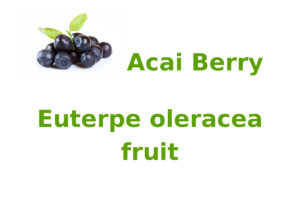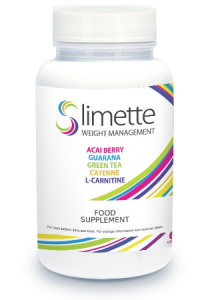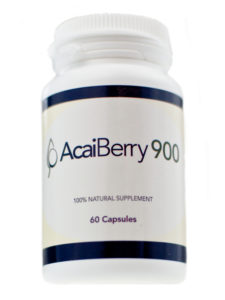 Açaí palm, (Euterpe oleracea) – a species of the arecaceae Palm family. It comes from the tropical areas of South America, but has been widespread in the intertropical area worldwide. The Palm fruit are called Acai berry (Euterpe oleracea fruit).
Açaí palm, (Euterpe oleracea) – a species of the arecaceae Palm family. It comes from the tropical areas of South America, but has been widespread in the intertropical area worldwide. The Palm fruit are called Acai berry (Euterpe oleracea fruit).
Fruits – Acai Berry
The fruit of Euterpe oleracea – acai berry (portugal. Açaí, ang. Acai berries) They resemble grapes, yet can be smaller, they include a large stone of a diameter from 7 to 10 mm and very little flesh. The tree bears berries twice a year in several or even a dozen clusters, containing from 500 to 900 berries.
Acai Berry – ingredients
So far none raw material (fruit) has been found in the world, which could compete with the acai berry in terms of nutritional value. Therefore Perricone called it “superfood on 1” (Table 1). Acai fruit is an extremely rich source of nutrients and dietary fiber and has a low water content, which in fresh fruit amounts only to 60%.
Acai berry is distinguished by the presence of the chemical composition of proteins of high biological value, containing all essential amino acids in the recommended proportions (Table 2).
The berries have a significant content of soluble vitamins (vitamin A and vitamin E), although fruits are also rich in vitamins B group and minerals (magnesium – Mg, Copper – Cu, Chromium – Cr, Zinc – Zn Manganese – Mn, Selenium – Se Potassium – K, Molybdenum – Mo, Iodine – I, Bor – B).
Acai berry and weight loss
Acai berries, thanks to the large amount of fiber (16.9 g per 100 g), accelerate metabolism (metabolism) and the process of digestion. They ensure a long-lasting feeling of satiety, and thus help to control and gradually reduce the amount of calories consumed. Owing to a very high content of tyrosine they are a natural fat burner. The antioxidants cleanse the body of unwanted toxins, and reduce the level of “bad” cholesterol. That is why weight loss with acai berry is so effective. If you are looking for weight loss products it is advisable to see our ranking of diet pills with acai berries: Ranking pills to lose weight with Acai Berry and the general: Ranking pills to lose weight.
Dietary supplements for weight lost with Acai Berry
There are many dietary supplements available on the market, containing acai berries. They are a common ingredient of products for weight loss. The best of them include: 100% Pure Acai Berry 700mg™, Pure Acai Berry Max™, Slimette.
| SILVETS ™ / SLIMETTE ™ |
|---|
 |
| |||||||
| ||||||||
          This product is available worldwide | ||||||||
| Acai Berry 900 ™ |
|---|
 |
| |||||||
| ||||||||
                            This product is available worldwide | ||||||||
The health benefits of acai berry

Acai fruit is used primarily to:
- help you increase your metabolism and the energy level
- enrich food supplements for weight loss (due to the high content of tyrosine),
- fight fatigue
- provide powerful antioxidant support
- treat catarrhal of gastrointestinal tract,
- treat skin diseases,
- subtitutive nutrition for infants when mother can not feed with her own breast.
Acai berry (Euterpe oleracea fruit) that grows on one of the most fertile soils in the world contains not only a wealth of antioxidants, but a balanced complex of unsaturated fatty acids, amino acids, phytosteroles, vitamins and many valuable elements.
Table 1
The energy value and the content of selected nutrients in Acai Berry
| Component | Content (w 100 g s.m.) |
|---|---|
| Energy value | 533,9 kcal |
| Total fat | 32,5 g |
| The sum of carbohydrates | 52,2 g |
| Dietary fiber | 44,2 g |
| Simple sugars | 1,3 g |
| Protein (F = 6,25) | 8,1 g |
| Vitamin A | 1002 IU |
| β-Carotene | < 5,0 IU |
| Vitamin C | < 0,1 mg |
| Calcium | 260,0 mg |
| Iron | 4,4 g |
| Ash | 3,8 g |
Table 2
The amino acid composition of protein in Acai Berry
| Amino acid | Content [%] |
|---|---|
| Aspartic acid | 0,83 |
| Threonine | 0,31 |
| Serine | 0,32 |
| Glutamic acid | 0,80 |
| Glycine | 0,39 |
| Alanine | 0,46 |
| Valine | 0,51 |
| Methionine | 0,12 |
| Isoleucine | 0,38 |
| Leucine | 0,65 |
| Tyrosine | 0,29 |
| Phenylalanine | 0,43 |
| Lysine | 0,43 |
| Histidine | 0,17 |
| Arginine | 0,42 |
| Proline | 0,53 |
| Hydroxyproline | < 0,01 |
| Cystine | 0,18 |
| Tryptophan | 0,13 |
| Sum | 7,59 |
Table 3
The contents of anthocyanins and polyphenols in must of acai berry
| Component | The content in the fresh weight (mg/L) |
|---|---|
| Cyanidin-3-glucoside | 1040 ± 58,2 |
| Pelargonidin-3-glucoside | 74,4 ± 2,90 |
| Ferulic acid | 212 ± 5,29 |
| (-) – Epicatechin | 129 ± 3,28 |
| P-hydroxybenzoic acid | 80,5 ± 2,00 |
| Gallic acid | 64,5 ± 1,64 |
| Protocatechuic acid | 64,4 ± 1,64 |
| (+) – Catechin | 60,8 ± 0,98 |
| Ellagic acid | 55,4 ± 1,39 |
| Vanillic acid | 33,2 ± 1,39 |
| P-coumaric acid | 17,1 ± 1,23 |
| Derivative of gallic acid-1 | 47,3 ±1,40 |
| Gallic acid derivative-2 | 18,4 ± 0,89 |
| Gallic acid derivative-3 | 17,3 ± 1,25 |
| Derivative of gallic acid-4 | 13,3 ± 0,96 |
| Gallic acid derivative-5 | 3,9 ± 0,18 |
| Ellagic acid derivative | 19,5 ± 0,40 |
References & External links
- Arabbi PR, Genovese MI, Lajolo FM., Flavonoids in vegetable food commonly consumed in Brazil and estimated ingestion by the Brazilian population, J Agric Food Chem 2004; 52:1124-31.
- Fillon M., The secret from the Amazon, Breakthrougns in health 2006; 4:43-9.
- Warren S. Acai crown jewel of the Amazon. Health J 2007; 95:1-4.
- Perricone N. The Perricone Promise. Ed. Warner Books, New York 2004.
- Araújo, Carina L., et al., Biological activity of proteins from pulps of tropical fruits, Food Chemistry 85.1 (2004): 107-110.
- Coïsson, J. D., et al., Euterpe oleracea juice as a functional pigment for yogurt, Food research international 38.8 (2005): 893-897.
- Schauss, Alexander G., et al., Antioxidant capacity and other bioactivities of the freeze-dried Amazonian palm berry, Euterpe oleraceae mart.(acai), Journal of Agricultural and Food Chemistry 54.22 (2006): 8604-8610.
- Surma-Zadora M, Cieślik E, Florkiewicz A. Antioxidant potential of Acai berry (Euterpe oleracea Mart.). Int Conf Risk Factors of Food Chain, 17th Sept. 2008, Kraków.
- Rodrigues, Roberta B., et al., Total oxidant scavenging capacity of Euterpe oleracea Mart.(açaí) seeds and identification of their polyphenolic compounds, Journal of agricultural and food chemistry 54.12 (2006): 4162-4167.
- Del Pozo-Insfran, David, Carmen H. Brenes, and Stephen T. Talcott., Phytochemical composition and pigment stability of Acai (Euterpe oleracea Mart.), Journal of Agricultural and Food Chemistry 52.6 (2004): 1539-1545.
- Gallori, S., Bilia, A. R., Bergonzi, M. C., Barbosa, W. L. R., & Vincieri, F. F. (2004). Polyphenolic constituents of fruit pulp of Euterpe oleracea Mart.(açai palm). Chromatographia, 59(11-12), 739-743.
- BOBBIO, F. O., DRUZIAN, J. I., ABRÃO, P. A., BOBBIO, P. A., & FADELLI, S. (2000). Identification and quantification of the anthocyanins from the fruit of açai (Euterpe oleracea) Mart. Food Science and Technology (Campinas), 20(3), 388-390.
- Hassimotto, Neuza Mariko Aymoto, Maria Inés Genovese, and Franco Maria Lajolo. Antioxidant activity of dietary fruits, vegetables, and commercial frozen fruit pulps. Journal of Agricultural and Food Chemistry 53.8 (2005): 2928-2935.
- Bobbio, F. O., Bobbio, P. A., Oliveira, P. A., & Fadelli, S. (2002). Stability and stabilization of the anthocyanins from Euterpe oleracea Mart. Acta Alimentaria, 31(4), 371-377.
- Wang, H., Cao, G., & Prior, R. L. (1997). Oxygen radical absorbing capacity of anthocyanins. Journal of agricultural and food chemistry, 45(2), 304-309.
- LICHTENTHÄLER, Ramona; MARX, Friedhelm. Total oxidant scavenging capacities of common European fruit and vegetable juices. Journal of agricultural and food chemistry, 2005, 53.1: 103-110.
- LICHTENTHÄLER, Ramona, et al. Total oxidant scavenging capacities of Euterpe oleracea Mart.(Acai) fruits. International Journal of Food Sciences and Nutrition, 2005, 56.1: 53-64.
- Global Wellness Report. Patent-pending process supercharges the Mona Vie blend, 2006. R3 Global, 1; 1-4.
- Sikora E, Cieślik E. Występowanie przeciwutleniaczy w owocach jagodowych. [W:] Grajek W (red.), Przeciwutleniacze w żywności. WN-T, Warszawa 2007; 201-9.
- SIKORA, Elżbieta; CIEŚLIK, Ewa; TOPOLSKA, Kinga. The sources of natural antioxidants. Acta Scientiarum Polonorum Technologia Alimentaria, 2008, 7.1: 5-17.
- Del Pozo-Insfran D, Percival SS, Talcott ST., Acai (Euterpeo oleracea Mart.) polyphenolics in their glycoside and aglycones forms induce apoptosis of HL-60 leukemia cells, J Agric Food Chem 2006; 54:1222-9.
- Surma-Zadora M, Cieślik E. Właściwości funkcjonalne związków fenolowych. Żyw Człow Metab 2007; 34(6):1648-56.
- CIEŚLIK, Ewa; GRĘDA, Anna; ADAMUS, Wiktor. Contents of polyphenols in fruit and vegetables. Food Chemistry, 2006, 94.1: 135-142.
- Cieślik, Ewa, and Kinga Topolska. Chemical composition and fuNctional properties of acai berry (Euterpe oleracea mart.), Postępy Fitoterapii (2012).
- Cieślik, Ewa, Agnieszka Gębusia, Charakterystyka właściwości prozdrowotnych owoców roślin egzotycznych, Post. Fitoter 2 (2012): 93-100.
- Schauss, Alexander G., Açaí: An Extraordinary Antioxidant-Rich Palm Fruit, Biosocial Publications, 2011.
- de Rosso, Veridiana Vera, et al., Determination of anthocyanins from acerola (Malpighia emarginata DC.) and açai (Euterpe oleracea Mart.) by HPLC–PDA–MS/MS, Journal of Food Composition and Analysis 21.4 (2008): 291-299.
- Schauss, Alexander G., et al., Phytochemical and nutrient composition of the freeze-dried Amazonian palm berry, Euterpe oleraceae Mart.(Acai), Journal of agricultural and food chemistry 54.22 (2006): 8598-8603.
- Hogan, Shelly, et al., Antiproliferative and antioxidant properties of anthocyanin-rich extract from açai, Food Chemistry 118.2 (2010): 208-214.
- Dr Alexander G. Schauss, Acai: An Extraordinary Antioxidant-Rich Palm Fruit from the Amazon, Wydawca: VideoPlus, ISBN: 9788393222285, 2013.
- Giuseppe Maffeis, Acai goji borówka. Trzy cudowne jagody, Wydawca: AWM Agencja Wydawnicza, ISBN: 9788372509833, 2015.
Legend
 Polska
Polska England
England The United States
The United States Deutschland
Deutschland España
España France
France Italia
Italia Sverige
Sverige Česká Republika
Česká Republika Hrvatska
Hrvatska Србија
Србија Latvija
Latvija Lietuva
Lietuva Eesti
Eesti Nederland
Nederland România
România България
България Österreich
Österreich Éire
Éire Portugal
Portugal Slovensko
Slovensko Slovenija
Slovenija Bosna i Hercegovina
Bosna i Hercegovina Schweiz
Schweiz Magyarország
Magyarország 中国
中国 Canada
Canada Australia
Australia Ελλάδα
Ελλάδα België
België Suomi
Suomi Colombia
Colombia Danmark
Danmark Norge
Norge ישראל
ישראל المغرب
المغرب Malaysia
Malaysia Україна
Україна Singapore
Singapore Pilipinas
Pilipinas پاکستان
پاکستان Cộng hòa xã hội chủ nghĩa Việt Nam
Cộng hòa xã hội chủ nghĩa Việt Nam  台湾
台湾 香港
香港 대한민국
대한민국 ประเทศไทย
ประเทศไทย Россия
Россия Türkiye
Türkiye Κύπρος
Κύπρος Indonesia
Indonesia भारत
भारत Тоҷикистон
Тоҷикистон საქართველო
საქართველო Nigeria
Nigeria Chile
Chile México
México Shqipëri
ShqipëriTranslations
| The article "Acai Berry (Euterpe oleracea fruit)" in other languages | |
|---|---|
| Acai Berry (Euterpe oleracea fruit) po Polsku. Acai Berry (Euterpe oleracea fruit) |  |





